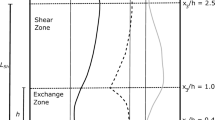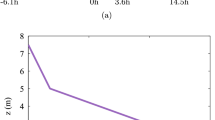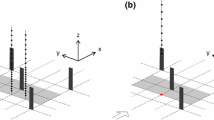Abstract
The study of turbulent flow across a vegetation discontinuity is of significant interest as such landscape features are common, and as there is no available theory to describe this regime adequately. We have simulated the three-dimensional dynamics of the airflow across a discontinuity between a forest (with a leaf area index of 4) and a clearing surface using large-eddy simulation. The properties of the bulk flow, as well as the large-scale coherent turbulent structures across the forest-to-clearing transition and the clearing-to-forest transition, are systematically explored. The vertical transport of the bulk flow upstream of the leading edge gives rise to the enhanced gust zone around the canopy top, while the transport downstream of the trailing edge leads to the formation of a recirculation zone above the clearing surface. The large-scale coherent structures across the two transitions exhibit both similarities with and differences from those upstream of the corresponding transition. For example, the ejection motion is dominant over the sweep motion in most of the region 1 < z/h < 2 (h is the canopy height) immediately downstream of the trailing edge, much as in the forested area upstream. Also, the streamwise vortex pair, which has previously been observed within the canopy sublayer and the atmospheric boundary layer, is consistently found across both transitions. However, the inflection observed both in the mean streamwise velocity, as well as in the vertical profiles of the coherent structures in the forested area, disappears gradually across the forest-to-clearing transition. The coherence of the turbulence, quantified by the percentage of the total turbulence kinetic energy that the coherent structures capture from the flow, decreases sharply immediately downstream of the trailing edge of the forest and increases downstream of the leading edge of the forest. The effects of the ratio of the forest/clearing lengths under a given streamwise periodicity on flow statistics and coherent turbulent structures are presented as well.
Similar content being viewed by others
References
Albertson JD (1996) Large-eddy simulation of land–atmosphere interaction. PhD Thesis, University of California Davis, 185 pp
Albertson JD, Parlange MB (1999a) Natural integration of scalar fluxes from complex terrain. Adv Water Resour 23: 239–252
Albertson JD, Parlange MB (1999b) Surface length scales and shear stress: implications for land–atmosphere interaction over complex terrain. Water Resour Res 35: 2121–2132
Albertson JD, Katul GG, Wiberg P (2001) Relative importance of local and regional controls on coupled water, carbon, and energy fluxes. Adv Water Resour 24: 1103–1118
Asner GP, Jonathan MO, Hicke JA (2003) Global synthesis of leaf area index observations: implications for ecological and remote sensing studies. Glob Ecol Biogeogr 12: 191–205
Berkooz G, Holmes P, Lumley JL (1993) The proper orthogonal decomposition in the analysis of turbulent flows. Annu Rev Fluid Mech 25: 539–575
Bou-Zeid E, Parlange MB, Meneveau C (2007) On the parameterization of surface roughness at regional scales. J Atmos Sci 64: 216–227
Cassiani M, Katul GG, Albertson JD (2008) The effects of canopy leaf area index on airflow across forest edges: large-eddy simulation and analytical results. Boundary-Layer Meteorol 126: 433–460
Chu CR, Parlange MB, Katul GG, Albertson JD (1996) Probability density functions of turbulent velocity and temperature in the atmospheric surface layer. Water Resour Res 32: 1681–1688
de Bruin HAR (1989) Physical aspects of the planetary boundary layer with special reference to regional evapotranspiration. In: Black TA, Spittlehouse DL, Novak MD, Price DT (eds) Estimation of areal evapotranspiration, vol 177, Vancouver, BC, Canada. IAHS Publication, Wallingford, pp 117–132
Deardorff JW (1972) Numerical investigations of neutral and unstable planetary boundary layers. J Atmos Sci 29: 91–115
Dupont S, Brunet Y (2008) Edge flow and canopy structure: a large-eddy simulation study. Boundary-Layer Meteorol 126: 51–71
Dwyer MJ, Patton EG, Shaw RH (1997) Turbulent kinetic energy budgets from a large-eddy simulation of airflow above and within a forest canopy. Boundary-Layer Meteorol 84: 23–43
Finnigan JJ (1979) Turbulence in waving wheat. 2. Structure of momentum-transfer. Boundary-Layer Meteorol 16: 213–236
Finnigan J (2000) Turbulence in plant canopies. Annu Rev Fluid Mech 32: 519–571
Finnigan JJ, Shaw RH (2000) A wind-tunnel study of airflow in waving wheat: an EOF analysis of the structure of the large-eddy motion. Boundary-Layer Meteorol 96: 211–255
Holmes P, Lumley JL, Berkooz G (1996) Turbulence, coherent structures, dynamical systems, and symmetry. Cambridge University Press, New York, p 420
Huang J, Cassiani M, Albertson JD (2009a) Analysis of coherent structures within the atmospheric boundary layer. Boundary-Layer Meteorol 131: 147–171
Huang J, Cassiani M, Albertson JD (2009b) The effects of vegetation density on coherent turbulent structures within the canopy sublayer: a large-eddy simulation study. Boundary-Layer Meteorol 133: 253–275
Irvine MR, Gardiner BA, Hill MK (1997) The evolution of turbulence across a forest edge. Boundary-Layer Meteorol 84: 467–496
Jochum MAO, de Bruin HAR, Holtslag AAM, Belmonte AC (2006) Area-averaged surface fluxes in a semiarid region with partly irrigated land: lessons learned from EFEDA. J Appl Meteorol Clim 45: 856–874
Katul GG, Albertson JD (1998) An investigation of higher-order closure models for a forested canopy. Boundary-Layer Meteorol 89: 47–74
Katul GG, Albertson JD, Hsieh CI, Conklin PS, Sigmon JT, Parlange MB, Knoerr KR (1996) The “inactive” eddy motion and the large-scale turbulent pressure fluctuations in the dynamic sublayer. J Atmos Sci 53: 2512–2524
Katul G, Poggi D, Cava D, Finnigan J (2006) The relative importance of ejections and sweeps to momentum transfer in the atmospheric boundary layer. Boundary-Layer Meteorol 120: 367–375
Kosovic B (1997) Subgrid-scale modelling for the large-eddy simulation of high-Reynolds-number boundary layers. J Fluid Mech 336: 151–182
Lu SS, Willmart WW (1973) Measurements of structure of reynolds stress in a turbulent boundary layer. J Fluid Mech 60: 481–511
Lumley JL (1967) The structure of inhomogeneous turbulent flows. In: Yagolm AM, Tatarsky VI (eds) Atmospheric turbulence and radio wave propagation. Nauka, Moscow, pp 166–178
Lumley JL (1970) Stochastic tools in turbulence. Academic Press, New York, p 194
Lumley JL (1981) Coherent structures in turbulence. In: Meyer RE (ed) Transition and turbulence. Academic, New York, pp 215–241
Mason PJ, Thomson DJ (1992) Stochastic backscatter in large-eddy simulations of boundary layers. J Fluid Mech 242: 51–78
Meijninger WML, Beyrich F, Luedi A, Kohsiek W, De Bruin HAR (2006) Scintillometer-based turbulent fluxes of sensible and latent heat over a heterogeneous land surface—a contribution to litfass-2003. Boundary-Layer Meteorol 121: 89–110
Michels BI, Jochum AM (1995) Heat and moisture flux profiles in a region with inhomogeneous surface evaporation. J Hydrol 166: 383–407
Moeng CH (1984) A large-eddy simulation model for the study of planetary boundary layer turbulence. J Atmos Sci 41: 2052–2062
Moin P, Moser RD (1989) Characteristic-eddy decomposition of turbulence in a channel. J Fluid Mech 200: 471–509
Ookouchi Y, Segal M, Kessler RC, Pielke RA (1984) Evaluation of soil moisture effects on the generation and modification of mesoscale circulations. Mon Weather Rev 112: 2281–2292
Patton EG, Davis KJ, Barth MC, Sullivan PP (2001) Decaying scalars emitted by a forest canopy: a numerical study. Boundary-Layer Meteorol 100: 91–129
Poggi D, Porporato A, Ridolfi L, Albertson JD, Katul GG (2004) The effect of vegetation density on canopy sub-layer turbulence. Boundary-Layer Meteorol 111: 565–587
Porte-Agel F, Meneveau C, Parlange MB (2000) A scale-dependent dynamic model for large-eddy simulation: application to a neutral atmospheric boundary layer. J Fluid Mech 415: 261–284
Raupach MR (1981) Conditional statistics of Reynolds stress in rough-wall and smooth-wall turbulent boundary-layers. J Fluid Mech 108: 363–382
Raupach MR, Finnigan JJ, Brunet Y (1996) Coherent eddies and turbulence in vegetation canopies: the mixing-layer analogy. Boundary-Layer Meteorol 78: 351–382
Schmidt H, Schumann U (1989) Coherent structure of the convective boundary layer derived from large-eddy simulations. J Fluid Mech 200: 511–562
Shaw RH, Schumann U (1992) Large-eddy simulation of turbulent-flow above and within a forest. Boundary-Layer Meteorol 61: 47–64
Shaw RH, Tavangar J, Ward DP (1983) Structure of the Reynolds stress in a canopy layer. J Clim Appl Meteorol 22: 1922–1931
Shen SH, Leclerc MY (1997) Modelling the turbulence structure in the canopy layer. Agric For Meteorol 87: 3–25
Sirovich L (1987a) Turbulence and the dynamics of coherent structures. 1. Coherent structures. Q Appl Math 45: 561–571
Sirovich L (1987b) Turbulence and the dynamics of coherent structures. 2. Symmetries and transformations. Quart Appl Math 45: 573–582
Sirovich L (1987c) Turbulence and the dynamics of coherent structures. 3. Dynamics and scaling. Q Appl Math 45: 583–590
Su HB, Shaw RH, Paw U KT (2000) Two-point correlation analysis of neutrally stratified flow within and above a forest from large-eddy simulation. Boundary-Layer Meteorol 94: 423–460
Su HB, Shaw RH, Paw U KT, Moeng CH, Sullivan PP (1998) Turbulent statistics of neutrally stratified flow within and above a sparse forest from large-eddy simulation and field observations. Boundary-Layer Meteorol 88: 363–397
Sullivan PP, McWilliams JC, Moeng CH (1996) A grid nesting method for large-eddy simulation of planetary boundary-layer flows. Boundary-Layer Meteorol 80: 167–202
Wilson DK (1996) Empirical orthogonal function analysis of the weakly convective atmospheric boundary layer. Part I: eddy structures. J Atmos Sci. 53: 801–823
Yang B, Morse AP, Shaw RH, Paw U KT (2006a) Large-eddy simulation of turbulent flow across a forest edge. Part II: momentum and turbulent kinetic energy budgets. Boundary-Layer Meteorol 121: 433–457
Yang B, Raupach MR, Shaw RH, Paw U KT, Morse AP (2006b) Large-eddy simulation of turbulent flow across a forest edge. Part I: flow statistics. Boundary-Layer Meteorol 120: 377–412
Author information
Authors and Affiliations
Corresponding author
Rights and permissions
About this article
Cite this article
Huang, J., Cassiani, M. & Albertson, J.D. Coherent Turbulent Structures Across a Vegetation Discontinuity. Boundary-Layer Meteorol 140, 1–22 (2011). https://doi.org/10.1007/s10546-011-9600-x
Received:
Accepted:
Published:
Issue Date:
DOI: https://doi.org/10.1007/s10546-011-9600-x




